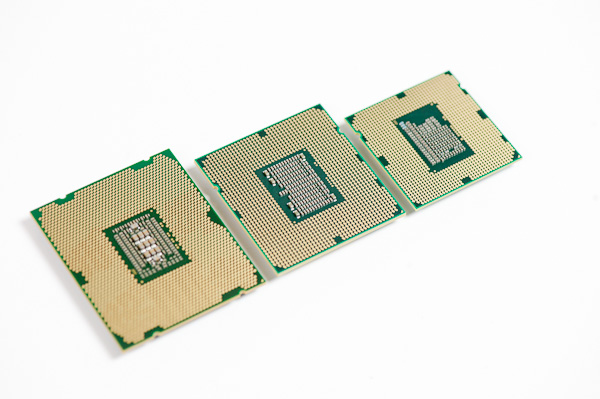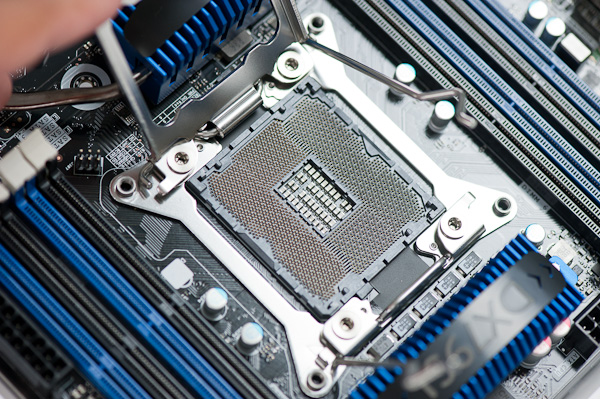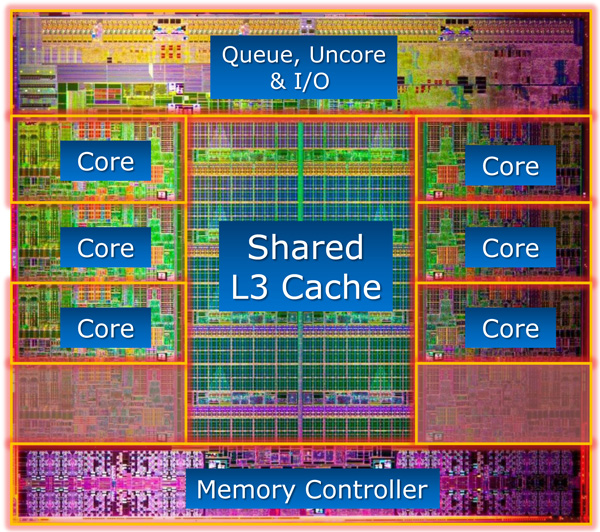Intel Core i7 3960X (Sandy Bridge E) Review: Keeping the High End Alive
by Anand Lal Shimpi on November 14, 2011 3:01 AM EST- Posted in
- CPUs
- Intel
- Core i7
- Sandy Bridge
- Sandy Bridge E
If you look carefully enough, you may notice that things are changing. It first became apparent shortly after the release of Nehalem. Intel bifurcated the performance desktop space by embracing a two-socket strategy, something we'd never seen from Intel and only once from AMD in the early Athlon 64 days (Socket-940 and Socket-754).
LGA-1366 came first, but by the time LGA-1156 arrived a year later it no longer made sense to recommend Intel's high-end Nehalem platform. Lynnfield was nearly as fast and the entire platform was more affordable.
When Sandy Bridge launched earlier this year, all we got was the mainstream desktop version. No one complained because it was fast enough, but we all knew an ultra high-end desktop part was in the works. A true successor to Nehalem's LGA-1366 platform for those who waited all this time.

Left to right: Sandy Bridge E, Gulftown, Sandy Bridge
After some delays, Sandy Bridge E is finally here. The platform is actually pretty simple to talk about. There's a new socket: LGA-2011, a new chipset Intel's X79 and of course the Sandy Bridge E CPU itself. We'll start at the CPU.
For the desktop, Sandy Bridge E is only available in 6-core configurations at launch. Early next year we'll see a quad-core version. I mention the desktop qualification because Sandy Bridge E is really a die harvested Sandy Bridge EP, Intel's next generation Xeon part:
If you look carefully at the die shot above, you'll notice that there are actually eight Sandy Bridge cores. The Xeon version will have all eight enabled, but the last two are fused off for SNB-E. The 32nm die is absolutely gigantic by desktop standards, measuring 20.8 mm x 20.9 mm (~435mm^2) Sandy Bridge E is bigger than most GPUs. It also has a ridiculous number of transistors: 2.27 billion.
Around a quarter of the die is dedicated just to the chip's massive L3 cache. Each cache slice has increased in size compared to Sandy Bridge. Instead of 2MB, Sandy Bridge E boasts 2.5MB cache slices. In its Xeon configuration that works out to 20MB of L3 cache, but for desktops it's only 15MB. That's just 1MB shy of how much system memory my old upgraded 386-SX/20 had.
| CPU Specification Comparison | ||||||||
| CPU | Manufacturing Process | Cores | Transistor Count | Die Size | ||||
| AMD Bulldozer 8C | 32nm | 8 | 1.2B* | 315mm2 | ||||
| AMD Thuban 6C | 45nm | 6 | 904M | 346mm2 | ||||
| AMD Deneb 4C | 45nm | 4 | 758M | 258mm2 | ||||
| Intel Gulftown 6C | 32nm | 6 | 1.17B | 240mm2 | ||||
| Intel Sandy Bridge E (6C) | 32nm | 6 | 2.27B | 435mm2 | ||||
| Intel Nehalem/Bloomfield 4C | 45nm | 4 | 731M | 263mm2 | ||||
| Intel Sandy Bridge 4C | 32nm | 4 | 995M | 216mm2 | ||||
| Intel Lynnfield 4C | 45nm | 4 | 774M | 296mm2 | ||||
| Intel Clarkdale 2C | 32nm | 2 | 384M | 81mm2 | ||||
| Intel Sandy Bridge 2C (GT1) | 32nm | 2 | 504M | 131mm2 | ||||
| Intel Sandy Bridge 2C (GT2) | 32nm | 2 | 624M | 149mm2 | ||||
Update: AMD originally told us Bulldozer was a 2B transistor chip. It has since told us that the 8C Bulldozer is actually 1.2B transistors. The die size is still accurate at 315mm2.
At the core level, Sandy Bridge E is no different than Sandy Bridge. It doesn't clock any higher, L1/L2 caches remain unchanged and per-core performance is identical to what Intel launched earlier this year.
The Lineup
| Processor | Core Clock | Cores / Threads | L3 Cache | Max Turbo | Max Overclock Multiplier | TDP | Price |
| Intel Core i7 3960X | 3.3GHz | 6 / 12 | 15MB | 3.9GHz | 57x | 130W | $990 |
| Intel Core i7 3930K | 3.2GHz | 6 / 12 | 12MB | 3.8GHz | 57x | 130W | $555 |
| Intel Core i7 3820 | 3.6GHz | 4 / 8 | 10MB | 3.9GHz | 43x | 130W | TBD |
| Intel Core i7 2700K | 3.5GHz | 4 / 8 | 8MB | 3.9GHz | 57x | 95W | $332 |
| Intel Core i7 2600K | 3.4GHz | 4 / 8 | 8MB | 3.8GHz | 57x | 95W | $317 |
| Intel Core i7 2600 | 3.4GHz | 4 / 8 | 8MB | 3.8GHz | 42x | 95W | $294 |
| Intel Core i5 2500K | 3.3GHz | 4 / 4 | 6MB | 3.7GHz | 57x | 95W | $216 |
| Intel Core i5 2500 | 3.3GHz | 4 / 4 | 6MB | 3.7GHz | 41x | 95W | $205 |
Those of you buying today only have two options: the Core i7-3960X and the Core i7-3930K. Both have six fully unlocked cores, but the 3960X gives you a 15MB L3 cache vs. 12MB with the 3930K. You pay handsomely for that extra 3MB of L3. The 3960X goes for $990 in 1K unit quantities, while the 3930K sells for $555.
The 3960X has the same 3.9GHz max turbo frequency as the Core i7 2700K, that's with 1 - 2 cores active. With 5 - 6 cores active the max turbo drops to a respectable 3.6GHz. Unlike the old days of many vs. few core CPUs, there are no tradeoffs for performance when you buy a SNB-E. Thanks to power gating and turbo, you get pretty much the fastest possible clock speeds regardless of workload.
Early next year we'll see a Core i7 3820, priced around $300, with only 4 cores and a 10MB L3. The 3820 will only be partially unlocked (max OC multiplier = 4 bins above max turbo).


















163 Comments
View All Comments
mcturkey - Monday, November 14, 2011 - link
Glad I'm not the only one who was thinking that! My 486 66 only had 4MB as well.Anand Lal Shimpi - Monday, November 14, 2011 - link
My 386 started with 4MB, but I kept it for a very long time as upgrading was fairly expensive. I eventually threw a ton of memory at it as my last upgrade to the platform :)Take care,
Anand
BSMonitor - Monday, November 14, 2011 - link
How big was your 386's hard drive?How many times over could you store it's entire contents in 8 DIMM's of DDR3 memory, now ?? And for probably less cost!
Thought I saw a 16GB kit on newegg for $75? Lol!
just4U - Monday, November 14, 2011 - link
I had a roomie 81 meg harddrive in my 386/16khanov - Monday, November 14, 2011 - link
"With the socket the same, is the reviewed SB-E the same design as the new Xeons? Will there be 3D design like Ivy Bridge?"1. It is the exact same die as the new Xeons, although of course different parts are harvested for each market.
2. Yes there will be a 3D transistor design (according to rumors) but this will be Ivy Bridge-E and will not launch until at least late 2012.
gamoniac - Monday, November 14, 2011 - link
Anand,More and more power users are running VMs on their desktops or workstation. With most Intel and AMD CPU now support Intel-VT or AMD-V, I notice a lack of measurement in this department in pretty much all online reviews. When you update your test suite, could you possibly include some sort VM test? Note: If so, could you possibly run the VM test on SSD to eliminate HDD limitation?
Thanks for the great review and conclusion, as always.
Senti - Monday, November 14, 2011 - link
I'm amazed how much fuss QuickSync is still generating in reviews. Let's face it - it's fairly useless in current state. Cool words "GPU video transcoding" can only impress casual users, not someone who cares about quality in first place and speed only after that.With time it will be even more useless if like GPU video decoding it's unable to work with 10 bit and 422/444 content (very likely).
gunslinger5577 - Monday, November 14, 2011 - link
This review indicates no significant improvement with 2x 16x PCI-E lanes in SLI. However the ASUS X79 Pro MB review seems to indicate there is a measurable and significant at times advantage.fishbits - Monday, November 14, 2011 - link
Weird stuff. Why fret over on-die USB 3.0 when every mobo supports it? And mourning Quick Sync for a CPU that flies at encoding without it? Or when you'd already have an SNB with Quick Sync? Really unhappy with the new Porche's glove compartment...Love the CPU/Platform, but too pricey for how much I'd use it over what's currently available. Hoping against hope that mainstream Ivy offers 8 RAM slots, but not holding my breath.
DanNeely - Monday, November 14, 2011 - link
Each addon chip the mobo makers include increases the cost of the board (not just the chip itself, but the engineering time needed to integrate it, and potentially (if enough are chips are added) by adding an extra layer to the PCB).You also take a hit in the number of PCIe lanes available for expansion slots. With legacy PCI gone from the southbridge we're unlikely to see any 4x electrical slots coming off of it. Audio, ethernet, and firewire, will take 1 lane each; USB3 controllers will take 1lane/2 ports, probably 3lanes total/board leaving only 2 for expansion slots. THe main impact here is just not being able to go all USB3 for the legacy free gloss without a major squeeze elsewhere. Scientific customers doing stuff that actually needs the PCE 3.0 bandwidth without needing 2x width cards could end up being dinged since it means several fewer total lanes for them to hook stuff up to.